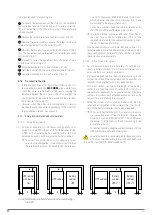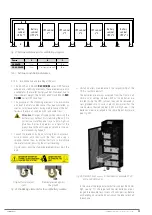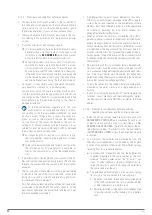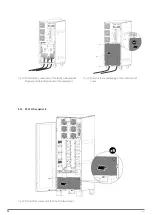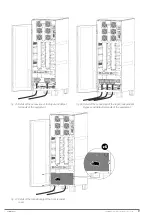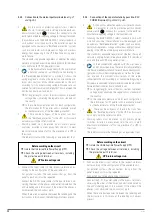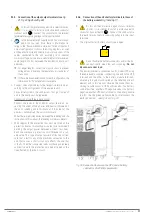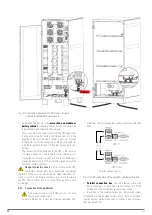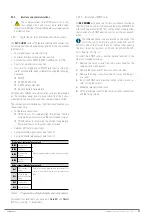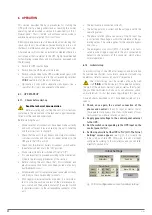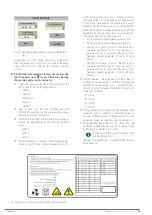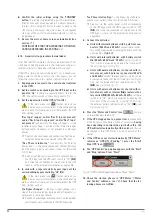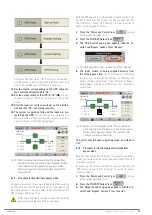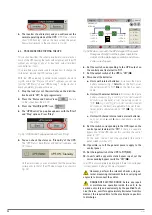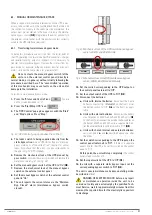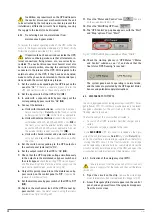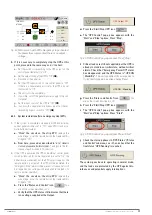
34
SALICRU
5.1.5.4. Preliminary considerations before connection
• The
description of this manual refers to the connection of
terminals and switch operations that are only available in
certain versions or units with extended autonomy. Ignore
the related operations if your unit does not have them.
• Follow and observe the instructions described in this sec-
tion relating to the installation of a single unit or a parallel
system.
• Protection or external manual bypass board:
It is recommended to have an external manual bypass
panel provided with input, output, static bypass (the
latter only in the
SLC CUBE4 B
version) and manual
bypass protection devices in single installations.
For parallel systems of up to two units, it is highly rec-
ommended to have a protection board and it is essen-
tial for systems of 3 or more units. The switches on the
board must allow a UPS to be isolated from the system
in the event of an anomaly and the loads to be supplied
via the remaining ones, either during the period of pre-
ventive maintenance or during the fault and its repair.
• On request, it is possible to supply an external manual by-
pass panel for a single unit or a parallel system.
You can also choose to have the installer provide and in-
stall this external board, paying attention to the version
and configuration of the unit or system available and to the
documentation on the pen drive relating to the "Recom-
mended installation".
•
In the documentation supplied with this user
manual and/or on your pen drive, there is informa-
tion relating to the "Recommended installation" for each
input and output configuration. It shows the wiring dia-
grams, as well as the protection size and the minimum
cross-sections of the cables connected to the unit, ac-
cording to its nominal working voltage. All values are cal-
culated for total maximum cable length of 30 m between
the distribution board, unit and loads.
For longer lengths, correct the cross-sections to pre-
vent voltage drops, observing the regulations or stand-
ards of the country.
In the same documentation and for each configuration,
the information for "N" parallel units is available, as
well as the characteristics of the "Back-feed protec-
tion".
• In parallel systems, the length and cross-section of the ca-
bles that run from the protection board to each UPS and from
these to the board will be the same for all of them without
exception.
• The cross-section of the cables must always be considered
in relation to the size of the switch terminals, so that their
entire cross-section is correctly embraced for optimal con-
tact between the two elements.
• Only the nominal currents are printed on the unit's name plate,
as indicated in the EN-IEC 62040-1 safety standard. For the
input current calculation, the power factor and the unit's per-
formance have been considered.
• If peripheral input, output or bypass elements such as trans-
formers or autotransformers are added to the UPS or parallel
system, the currents indicated on the name plates of these
elements must be considered in order to use the appropriate
cross-sections, observing the local and/or national Low
Voltage Electrotechnical Regulations.
• When an isolation transformer is incorporated into a UPS or
parallel system, as standard, as an option or installed by you,
either at the input, bypass or output line or at all of them, pro-
tection devices against indirect contact (differential switch)
must be fitted at the output of each transformer, as due to its
isolation characteristics, it will prevent the tripping of the pro-
tection devices fitted in the primary of the disconnect switch
in the event of electric shock in the secondary (isolation trans-
former output).
• Please note that all factory-installed or factory-supplied isola-
tion transformers have the output neutral connected to earth
via a connection bridge between the neutral and earth termi-
nals. If the output neutral must be isolated, this bridge must
be removed, taking the precautions indicated in the respective
local and/or national low voltage regulations.
• To pass the cables into the cabinet, there are cable glands
mounted on the metal structure or a single opening as a
bushing.
•
In case of installing the equipment in IT neutral regime, the
switches, circuit breakers and thermal-magnetic protec-
tion devices must break the NEUTRAL, as well as the three
phases.
5.1.5.5. Preliminary considerations before connection,
regarding the batteries and their protection devices
•
Inside the battery cabinet there are accessible parts with
DANGEROUS VOLTAGES
and consequently with a risk
of electric shock, which is why it is classified as a
RE-
STRICTED ACCESS AREA
. Therefore the key for the ex-
ternal battery cabinet (if present) will not be available to
the
OPERATOR or USER
, unless they have been properly
instructed.
• As a minimum, the batteries are protected by fuses and
their physical arrangement is conditioned by the tangible
location of the batteries themselves. The different groups
resulting from this are detailed below:
a.
In models with "standard" autonomy, the batteries are
supplied integrated in the same cabinet as the unit.
Likewise, for each power output, the "0/" and "/" ver-
sions, in their standard autonomy configuration, re-
serve the necessary space for locating the batteries in
the same cabinet as the unit.
b.
The extended autonomy models are a variant of group
"
a
", which in turn are divided into two subgroups:
1.
Batteries installed or intended to be installed partly
in the UPS cabinet and the rest in another cabinet
or other cabinets or in a battery rack.
2.
Batteries installed or intended to be installed entirely
in another cabinet or other cabinets or in a battery
rack.













